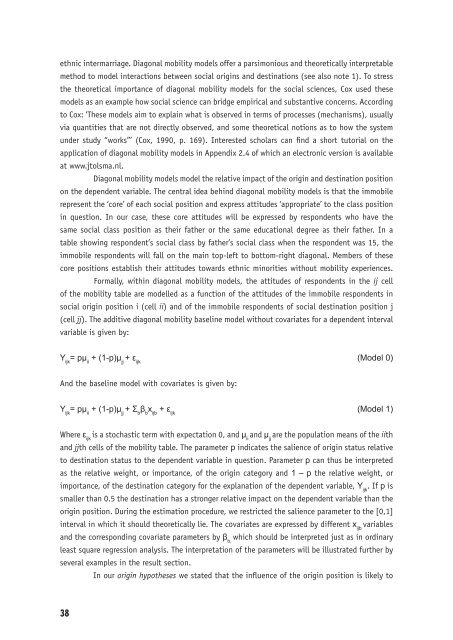Ethnic Hostility among Ethnic Majority and Minority Groups
Ethnic Hostility among Ethnic Majority and Minority Groups
Ethnic Hostility among Ethnic Majority and Minority Groups
Create successful ePaper yourself
Turn your PDF publications into a flip-book with our unique Google optimized e-Paper software.
ethnic intermarriage. Diagonal mobility models offer a parsimonious <strong>and</strong> theoretically interpretable<br />
method to model interactions between social origins <strong>and</strong> destinations (see also note 1). To stress<br />
the theoretical importance of diagonal mobility models for the social sciences, Cox used these<br />
models as an example how social science can bridge empirical <strong>and</strong> substantive concerns. According<br />
to Cox: ‘These models aim to explain what is observed in terms of processes (mechanisms), usually<br />
via quantities that are not directly observed, <strong>and</strong> some theoretical notions as to how the system<br />
under study “works”’ (Cox, 1990, p. 169). Interested scholars can fi nd a short tutorial on the<br />
application of diagonal mobility models in Appendix 2.4 of which an electronic version is available<br />
at www.jtolsma.nl.<br />
Diagonal mobility models model the relative impact of the origin <strong>and</strong> destination position<br />
on the dependent variable. The central idea behind diagonal mobility models is that the immobile<br />
represent the ‘core’ of each social position <strong>and</strong> express attitudes ‘appropriate’ to the class position<br />
in question. In our case, these core attitudes will be expressed by respondents who have the<br />
same social class position as their father or the same educational degree as their father. In a<br />
table showing respondent’s social class by father’s social class when the respondent was 15, the<br />
immobile respondents will fall on the main top-left to bottom-right diagonal. Members of these<br />
core positions establish their attitudes towards ethnic minorities without mobility experiences.<br />
Formally, within diagonal mobility models, the attitudes of respondents in the ij cell<br />
of the mobility table are modelled as a function of the attitudes of the immobile respondents in<br />
social origin position i (cell ii) <strong>and</strong> of the immobile respondents of social destination position j<br />
(cell jj). The additive diagonal mobility baseline model without covariates for a dependent interval<br />
variable is given by:<br />
Y ijk = pμ ii + (1-p)μ jj + ε ijk<br />
And the baseline model with covariates is given by:<br />
Y ijk = pμ ii + (1-p)μ jj + Σ b β b x ijb + ε ijk<br />
38<br />
(Model 0)<br />
(Model 1)<br />
Where ε is a stochastic term with expectation 0, <strong>and</strong> μ <strong>and</strong> μ are the population means of the iith<br />
ijk ii jj<br />
<strong>and</strong> jjth cells of the mobility table. The parameter p indicates the salience of origin status relative<br />
to destination status to the dependent variable in question. Parameter p can thus be interpreted<br />
as the relative weight, or importance, of the origin category <strong>and</strong> 1 – p the relative weight, or<br />
importance, of the destination category for the explanation of the dependent variable, Y . If p is<br />
ijk<br />
smaller than 0.5 the destination has a stronger relative impact on the dependent variable than the<br />
origin position. During the estimation procedure, we restricted the salience parameter to the [0,1]<br />
interval in which it should theoretically lie. The covariates are expressed by different x variables<br />
ijb<br />
<strong>and</strong> the corresponding covariate parameters by β which should be interpreted just as in ordinary<br />
b,<br />
least square regression analysis. The interpretation of the parameters will be illustrated further by<br />
several examples in the result section.<br />
In our origin hypotheses we stated that the infl uence of the origin position is likely to












